Newtown Rd. isn’t named for the neighborhood where it is, but for the neighborhood it runs to. And, like a number of NYC streets that run aslant the overall grid, it’s one of the area’s older roads. It’s an Indian trail that became the main road to early Astoria settler William Hallett’s farm in the mid-17th century, and to Hell Gate, the East River crossing to Manhattan. Its eastern stretch that ended in the heart of Newtown, now Elmhurst, was called Hurlgate, or Hellgate, Ferry Rd,; later named for the town through which it passed, becoming Woodside Ave.
At Newtown Rd. and 46th St., shown here, there are some older buildings that have odd angles. This is the last remnant of a village called Middletown (likely called because it lay between old Astoria and Newtown) instituted in the 17th century. In 1721 one of Queens’ first schools was located here at the confluence of Newtown and Old Ridge Rds. British and Hessian troops marched by the school during the American Revolution. A century later, some schoolboys found a cache of gold coins worth $840 in its walls, likely hidden during the Revolution.
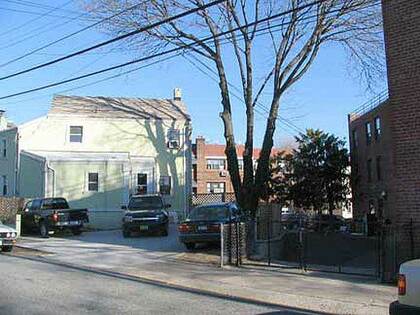
Today, the school is long gone, but Old Ridge Rd. still exists in the form of a curving driveway seen here in the foreground. Another piece can be found between 37th and 38th Aves. and 29th and 30th Sts., and an old house is still turned to face the now-disappeared road on 33rd St. south of Broadway.
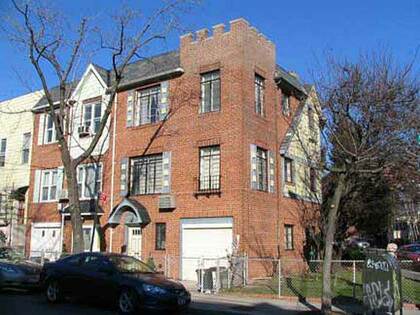
Ancient villages and gold caches aside, Newtown and 46th has some striking architecture. Here’s a castellated corner building with casement windows with terra cotta trim.
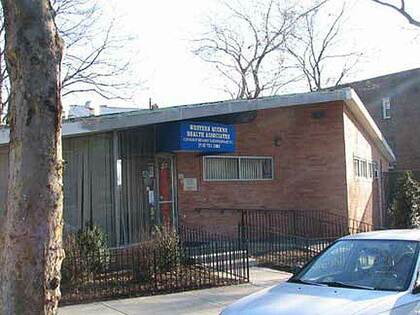
I like this Western Queens Health Associates building on Newtown and 45th, with its glass front and pitched roof, it’s got style to burn.
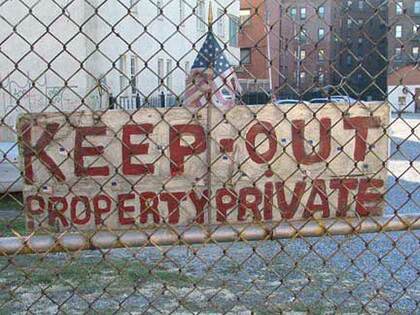
I was stumped when I found a garage, surrounded by a lawn, barbed wire and ragged windblown American flags. It wasn’t till I rounded the corner onto 31st Ave. that I discovered it was part of a private parking lot owned by a Mister Fiore. I then encountered a Guardian, a neighborhood resident dedicated to defending turf against perceived hostile outsiders.
“May I help you?” came a disembodied woman’s voice. In New York City, “May I help you” means, “stop what you’re doing and go away, a–hole.” (Corollary: in New York City, “Sir!” means “a–hole!”)
“No, you most certainly may not.” I now adopt an air of dismissiveness when dealing with Guardians.
“What are you doing?” she asked redundantly.
“I am taking pictures of your parking lot,” I answered from the public sidewalk in front of the lot.
There were no further provocations.
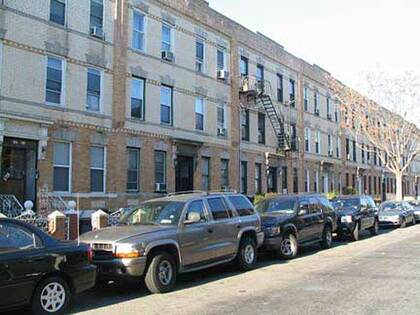
“Mathews models” on 44th St. north of 31st Ave. (Around here all the street numbers can be found under N on a Bingo card.) Points deducted, since they don’t extend all the way down the block, lack the arched windows, and aren’t on both sides of the street. These were built by developer Gustave X. Mathews in the 1910s, using yellow bricks fired in the kilns of Balthazar Kreischer on the southwest shore of Staten Island. Mathews continued to build until the early-1930s, with the last batch on Grand Ave. in Elmhurst.
Unfortunately, as attached houses, Mathews Models lack garages in the back, the only esthetically-minded solution to where to put a car. Today’s “Fedders Specials” are built with garages in the basement, or simple unpaved areas in front where the SUV goes. Neither is an attractive method of vehicle storage.

Another of Long Island City’s great multi-unit buildings, 31st Ave. and 43rd St. In the 1920s and 30s, the golden age of multi-unit architecture, the transition was made from Beaux-Arts to Art Deco and Moderne, and some striking houses appeared. Here’s some great door detail, as well as falcons on the roof. What developer could pull this off today without complete cheesiness?
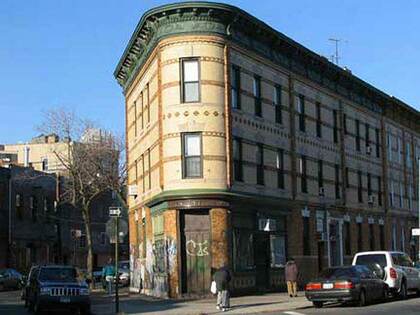
The Flatiron Building at 5th, Broadway and 23rd in Manhattan is often mentioned as the first skyscraper and first great “triangle’ building, but there are so many around town. The best ones thrust into the streetscape like the prow of a ship. This one is a Mathews Model and appeared after 1915, and complements a group of great Mathews Models on 41st between Newtown and 30th Ave.

I lived in an attached yellow-brick apartment buildings like these (not Matthews Flats though) in Bay Ridge from 1982-1990. It was my favorite living arrangement. It was a railroad flat and had both northern and southern exposure, so I could see both moon/sunrise and moon/sunset. Not to mention the Verrazzano Bridge from the “media room” (my turntable, LP collection and receiver) and, if I squinted during the winter, the Williamsburg Bank Building from the bedroom. (It was officially a one-bedroom, but the kitchen and living room were combined.) I was forced out when the owner used the old gag about his daughter needing the apartment. What they did was renovate the place and then ask me back at double the rent. No thanks. I eventually wound up in Flushing, and eventually Little Neck.
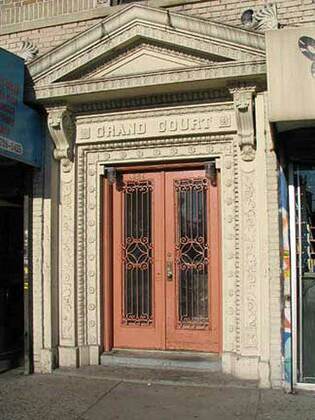
Newtown Rd. ends here at Grand Court, at 30th Ave. That’s not just a door, it’s an entrance. Like many LIC apartment house names, it holds a clue to the past. 30th Ave. used to be called Grand Ave. (nothing to do with Maspeth/Elmhurst’s Grand Ave.; that road was called Grand St. and begins in Williamsburg).
—Kevin Walsh is the webmaster of the award-winning website Forgotten NY, and the author of the books Forgotten New York (HarperCollins, 2006) and also, with the Greater Astoria Historical Society, Forgotten Queens (Arcadia, 2013)

